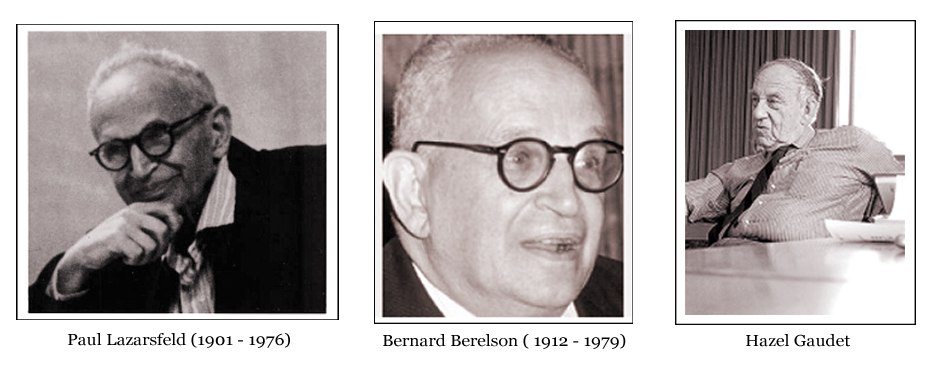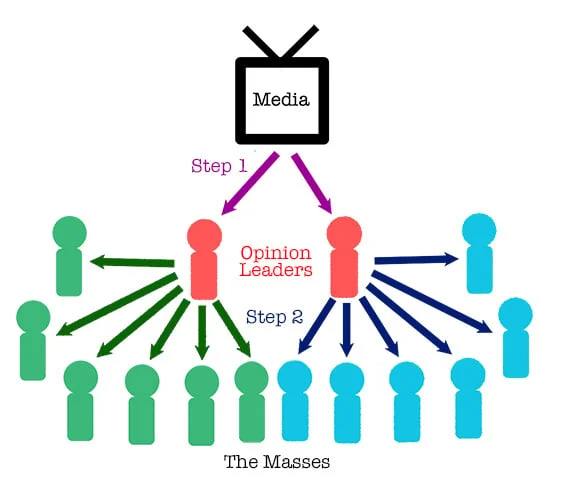What is the two-step flow theory? According to Google, the two-step flow theory suggests that people are directly influenced by mass media. The two-step flow theory suggests that interpersonal communication is more important than media exposure in the decision-making process.┬Ā
Intro to the two-step flow theory
The two-step flow model of communication is a theory introduced in 1948 by Paul Lazarsfeld, Bernard Berelson, and Hazel Gaudet in their book ‘ The People’s Choice’. It challenges the traditional belief that mass media directly and uniformly influences people’s opinions and behaviours. Instead, the theory argues that information from mass media first reaches a small group of influential individuals who are are known as opinion leaders, these leaders then interpret and pass on this information to others. This means that most of the audience don’t get their information directly from the media, but they get their information which is interpreted by opinion leaders. So, the audience doesn’t know the real information that they are getting because the opinion leaders can be biased on what they are talking about, so they alter the stories in a way that they want the people to see and not what the people actually want to see.

The two stages
The model operated in two stages and the first stage is the opinion leaders. Opinion leaders are more active media consumers, absorb and interpret media messages. These individuals are usually better informed about political, social, and cultural issues. In the second stage, they share information with less active media consumers such as their friends and family. This helps to get a public opinion from personal interactions rather than hearing it from the media itself.
The two-step model of communication was developed from research conducted during the 1940 U.S. presidential election. Researchers found that most voters did not make their decisions based on direct exposure to media, such as newspapers or radio broadcasts. Instead, they relied on information passed to them through converstations with others who were more informed about the campaign. This finding suggested that word-of-mouth communication played a more significant role in shaping peopleŌĆÖs political opinions than direct media exposure. As a result, the researchers concluded that the influence of mass media on public opinion was more indirect than previously thought.
Before this model was introduced, the dominant theory of communication was the “hypodermic needle” model, also known as the “magic bullet” theory. This earlier theory assumed that mass media had a direct and powerful influence on audiences, treating people as passive consumers who absorbed messages without much critical thought. In contrast, the two-step flow model introduced a more complex view of media influence, showing that the effects of mass media were limited and that interpersonal relationships played a much bigger role in shaping peopleŌĆÖs decisions, particularly in politics.
One important finding from Lazarsfeld, Berelson, and GaudetŌĆÖs research was that only about┬Ā5 percent of voters┬Āchanged their political preferences based on media exposure alone. Most people formed their opinions through discussions with those around them, which highlighted the┬Āimportance of interpersonal communication┬Āin the decision-making process. This idea led to the development of the┬Ā“limited effects paradigm”, which was expanded by Joseph Klapper in his 1960 book┬ĀThe Effects of Mass Communication. This concept argues that mediaŌĆÖs influence is often┬Āsmall and indirect, with┬Āpersonal and social factors┬Āplaying a larger role in shaping peopleŌĆÖs behaviour .
While the two-step flow model has been widely supported through subsequent studies, it has also faced criticism. Some researchers argue that the model oversimplifies the process of communication, suggesting that information flows through more than just two steps. For example, opinion leaders often discuss media content among themselves before sharing it with less-informed people, creating more layers of communication. Others point out that the model was developed before the rise of television and the Internet, which have changed how people consume and share information. Today, many people rely more directly on mass media rather than interpersonal communication.
Despite these critiques, the two-step flow model remains an important theory in communication studies. It emphasizes the key role of opinion leaders and social networks in shaping public opinion, showing that mediaŌĆÖs influence is more indirect and mediated through personal relationships than initially believed.
References:
Britannica, two-step flow model of communication.


I really like how you have defined the Two-Step Flow Theory and have expanded more in detail. I found really interesting to know the “hypodermic needle” model as it shows how the society can be harshly influenced by the mass media, as they were treating people as passive consumers knowing that they will not criticise a message given. From this I like how you have compared it to the two step model, showing an evolution of the theory by giving a more complex of media influence.